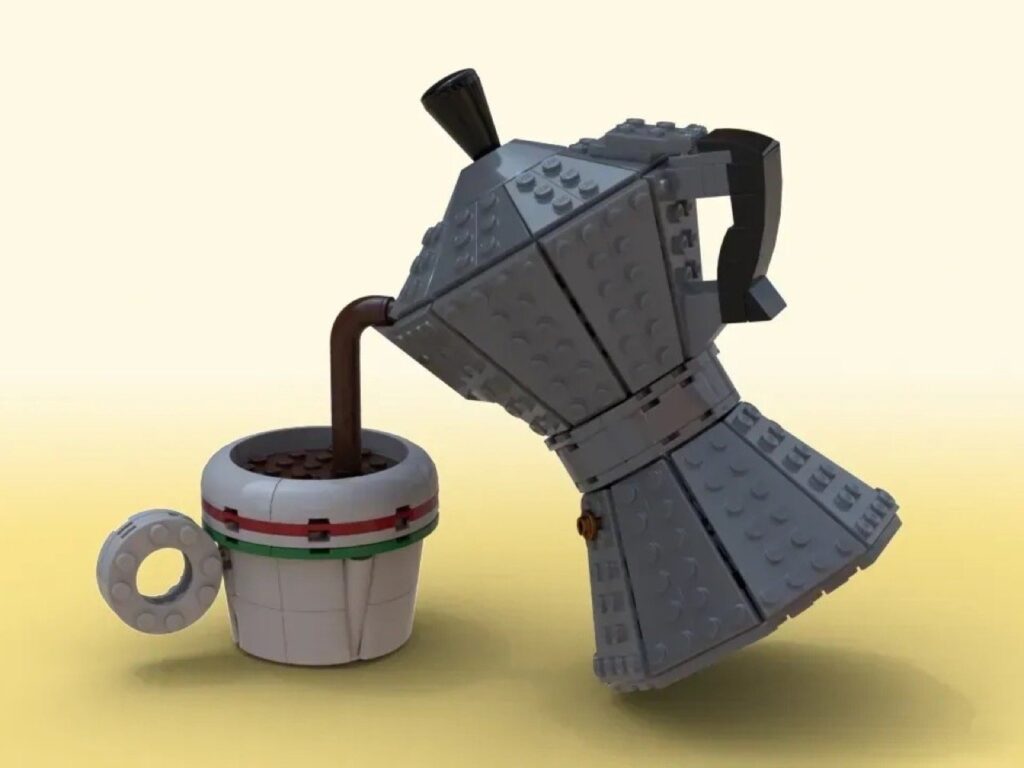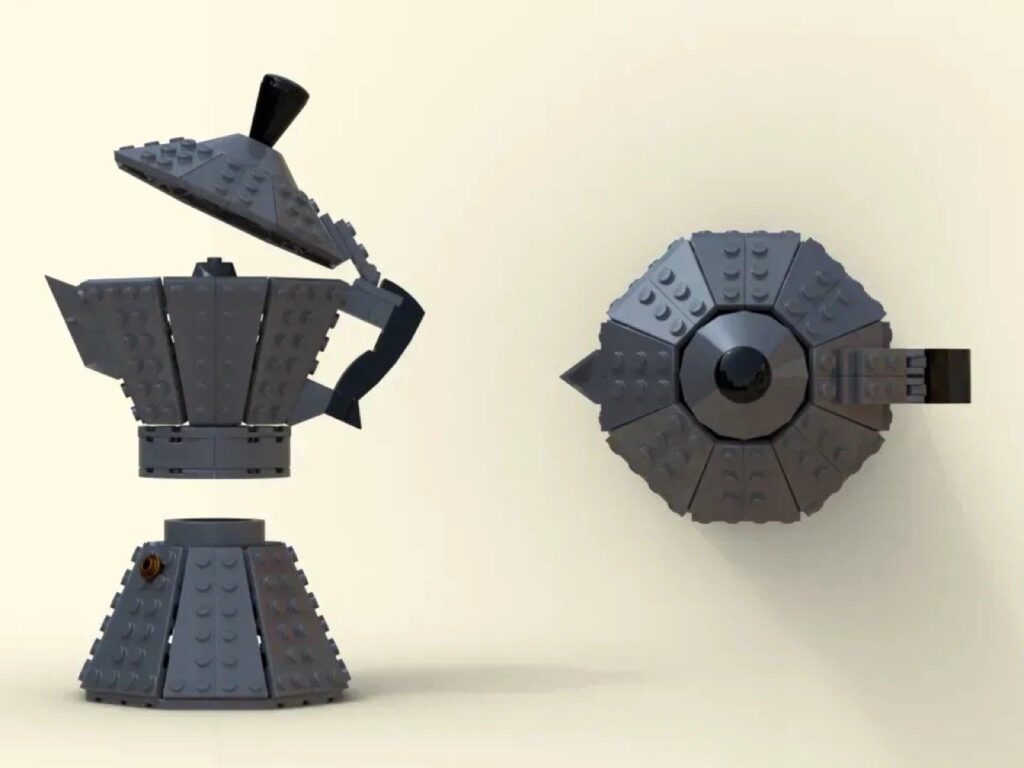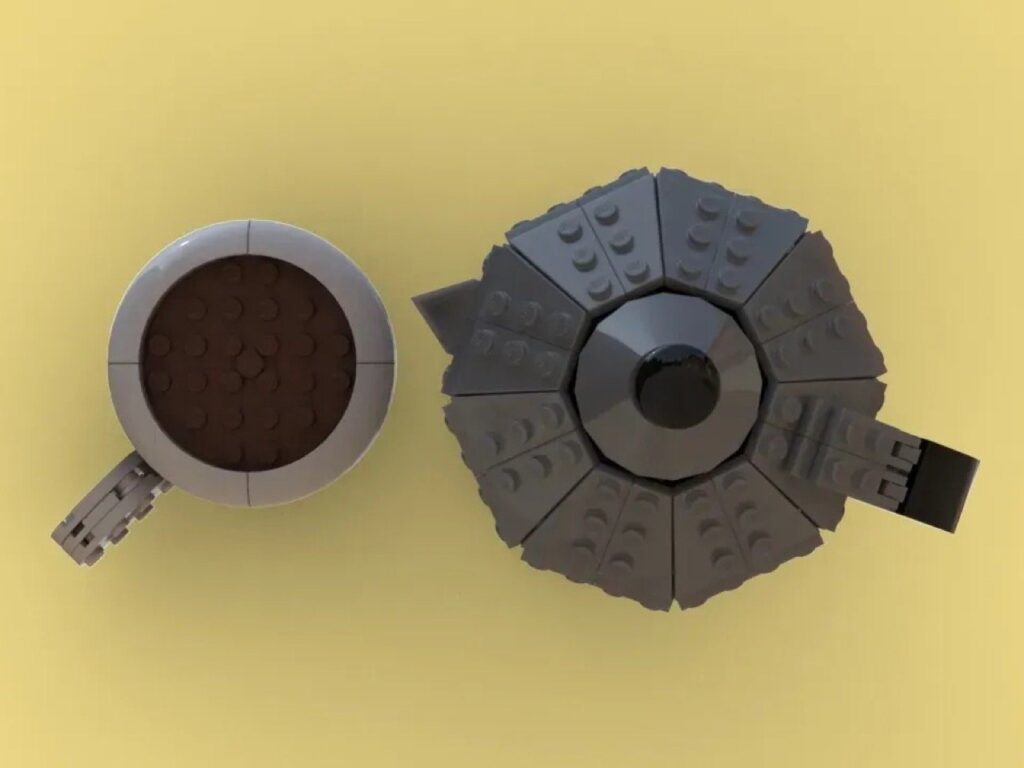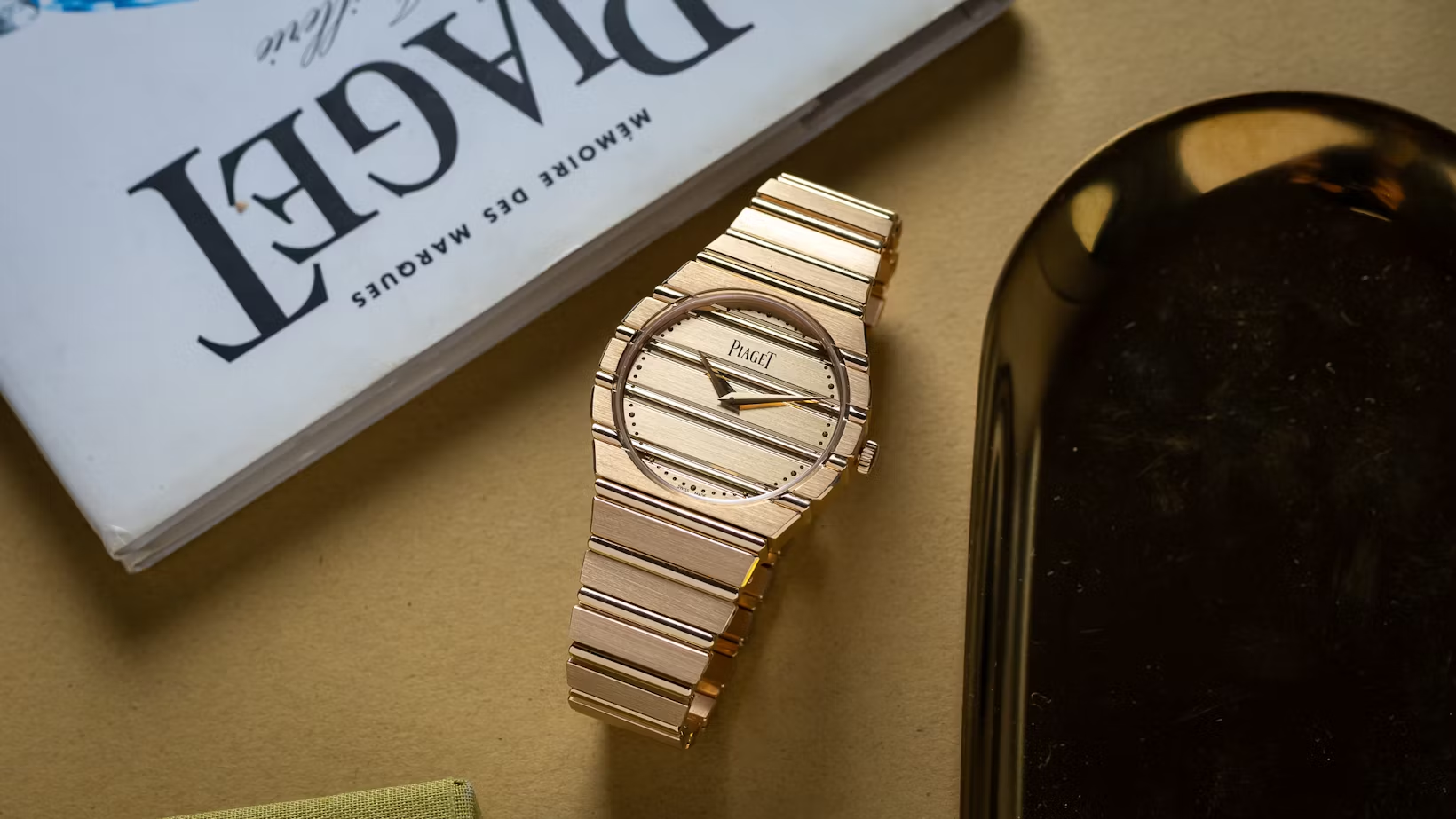If there’s one sound that defines an Italian morning, it’s not an alarm clock—it’s the rhythmic hiss of boiling water pushing through finely ground coffee in a Moka Pot. A simple yet genius invention by Alfonso Bialetti in 1933, this small aluminum contraption transformed home brewing forever. For generations, the Moka Pot has been the anchor of Italy’s daily rhythm, turning coffee into something more than a drink—it’s an act of art, heritage, and family.
Across the peninsula, from Milan to Palermo, that ritual has barely changed. Italians wake to the scent of moka bubbling on stovetops, its steam a quiet signal that the day has begun. The Moka Pot is a humble domestic altar. Its shape—angular, elegant, instantly recognizable—belongs to a rare class of objects that bridge functionality with identity.
And now, thanks to a creative LEGO builder who goes by the handle marky_lefty, the world’s most iconic coffee maker has entered the realm of brick-built artistry. His LEGO Moka Pot isn’t merely a miniature—it’s a love letter to Italian coffee culture, a nostalgic model that invites conjure, reverence, and a grin of familiarity from anyone who’s ever brewed espresso at home.
a machine that democratized espresso
When Alfonso Bialetti introduced his invention in the early 1930s, Italy was in the midst of a modernist design revolution. Futurism, geometry, and industrial optimism were reshaping how people viewed domestic life. Bialetti’s Moka Express captured all of that energy in polished aluminum. It was affordable, portable, and required no electricity—just heat and water.
For the first time, everyday Italians could make espresso-like coffee in their own kitchens without stepping into a café. The pot’s octagonal form wasn’t just an aesthetic choice—it was a functional breakthrough. The faceted body improved heat distribution, the funnel chamber ensured steady percolation, and the safety valve (a tiny brass detail still visible on the LEGO model) protected against overpressure.
What Bialetti created wasn’t simply a coffee maker; it was a symbol of self-sufficiency, of Italian craftsmanship meeting modern design. By the 1950s, the Moka Pot had become a global export, spreading both the taste of Italian coffee and the ethos of its design across continents.
Even today, the silhouette of that pot—with its proud little mustachioed man stamped on the side—feels both nostalgic and revolutionary. It’s as much a design icon as the Vespa, the Fiat 500, or Olivetti’s typewriters.
lego as design tribute
Enter LEGO builder marky_lefty. On the surface, his miniature Moka Pot seems like a charming curiosity—just a coffee maker rendered in plastic bricks. But look closer, and it becomes clear: this is a piece of design homage.
The LEGO Moka Pot captures every nuance of the original object’s industrial poetry. The octagonal geometry translates perfectly into the language of LEGO, where right angles and subtle tapers coexist. The silver-grey bricks mimic the brushed aluminum body. The black handle, curved yet rigid, mirrors the ergonomic simplicity of the real one. And perched atop it all, the tiny hinged lid with its studded knob—functional, tactile, familiar.
Even the pot’s two-part structure remains intact. Twist it apart and you’ll see how marky_lefty reinterprets the internal logic of Bialetti’s design in brick form. There’s a lower chamber for “water,” a middle funnel for “grounds,” and a top collector for the “coffee.” Of course, none of it actually brews, but the act of assembling it recalls the same mechanical intimacy as preparing a real espresso.
Then comes the detail that clinches the emotional connection: a miniature espresso cup in the colors of the Italian flag—green, white, and red. It’s both playful and profound, symbolizing national pride in one of Italy’s most sacred daily rituals.
coffee, culture, and construction
What makes the Moka Pot such fertile ground for reinterpretation is that it’s not just a kitchen tool—it’s a cultural artefact. Italy’s relationship with coffee is ritualistic and social, bound by codes of behavior that have survived decades of modernization.
Morning espresso is quick, communal, and deeply personal. It’s consumed standing at a bar counter, in conversation with friends or strangers. At home, it’s slower—a moment of meditation before the world intrudes. That contrast between speed and stillness, between design precision and emotional warmth, lies at the middle of both the Moka Pot and LEGO’s creative ethos.
LEGO, after all, is about building worlds—of structure, patience, and imagination. By re-building the Moka Pot in LEGO form, marky_lefty bridges two cultures that prize design discipline and everyday joy. Both Bialetti and LEGO stand as testaments to the idea that good design should be accessible, human, and timeless.
the aesthetic of the everyday
The Moka Pot’s visual strength comes from its blend of geometry and familiarity. Its hourglass body seems sculpted from pure function: wide at the base for heating, narrow in the middle for pressure, and flared at the top for pouring. Yet it also exudes personality.
Design historians often note how Italian industrial design thrives on this tension—the balance between precision and flow. From Alessi’s whistling kettles to Olivetti’s calculators, everyday objects become cultural symbols through form.
In marky_lefty’s hands, the Moka Pot becomes a new kind of still life. Its LEGO body doesn’t dilute its charm—it amplifies it. The modular texture makes the object feel contemporary again, reminding us that nostalgia and innovation aren’t opposites. They’re partners in storytelling.
nostalgia in miniature
In design culture, miniaturization often amplifies emotional resonance. Shrinking an icon down to handheld size makes it intimate, collectible, even tender. Think of the Mini Cooper, the Polaroid camera, or vinyl figurines of cultural icons.
It’s nostalgia in 1:10 scale—where every stud and tile becomes a pixel in a mosaic of collective memory.
lang
Every great design brand speaks a visual language. Bialetti’s vocabulary is instantly legible: polished aluminum, confident geometry, black handles, and the cartoonish “Omino con i baffi”—the little man with a mustache—etched on the pot’s side.
These symbols are so embedded in Italian domestic life that they operate almost subconsciously. To see a Moka Pot is to think “Italy.” It’s the same semiotic shorthand that Apple uses with its bitten apple, or Ferrari with its prancing horse.
By reimagining that form in LEGO bricks, marky_lefty reactivates those symbols in a global context. Now, a child in Denmark, a designer in Tokyo, or a collector in New York can instantly grasp the cultural weight of this tiny coffee maker. The Moka Pot becomes a shared design language across generations and geographies.
flow
Ultimately, the LEGO Moka Pot reminds us that design icons endure because they transcend material. Whether aluminum or ABS plastic, the form carries meaning beyond its substance.
It evokes mornings filled with steam and chatter, the clink of spoons against ceramic cups, the smell of roasted beans mingling with sunlight on tiled kitchens. It tells a story of invention, migration, and cultural pride.
To build it in LEGO is to celebrate not only Italian coffee culture, but also the universal joy of making—of transforming small pieces into something whole.
No comments yet.










